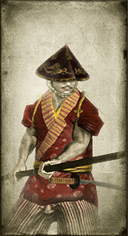
Basic Unit Statistics (can be modified by difficulty level, arts, skills, traits and retainers)
| Recruitment Cost | 580 | |
| Upkeep Cost | 80 | |
| Melee Attack | 4 | 11% |
| Charge Bonus | 6 | 12% |
| Bonus vs Cavalry | 20 | 66% |
| Melee Defence | 7 | 20% |
| Armour | 1 | 6% |
| Morale | 4 | 8% |
Strengths & Weaknesses
- Very good against cavalry.
- Vulnerable to missiles.
- Weak in melee against sword-armed units.
- Low morale.
Requires
Description
Armed with long spears, these men are incredibly effective against cavalry units.
Even in modern combat the spear is a remarkably useful weapon. It can be used in single or mass combat, and is equally effective for attack and defence. Spear levies are armed with long spears that are almost pikes and can be used to lead a battle charge. They are well-drilled, but lack the lifetime of skill and dedication that marks out the samurai. Spear levies are most effective when they work together as a block, forming a wall of spears. This compensates for their low morale and limits the amount of damage they take due to a lack of armour. Any cavalry that charges into a well-managed formation of spear levy will be severely depleted as the horses and riders are skewered. Gods and goddesses have been adopted and adapted throughout history. Some aspects of Japanese mythology have their roots in Buddhism, but the deities worshipped in Japan often bear little resemblance to the Buddhist deities they were based on. For example, Vaisravana, the chief of the Four Heavenly Kings, became the armour-clad Bishamonten when Buddhism spread through Japan. Although he retained the position of Guardian of the North, he took on the more brutal mantle of God of War: gone was the umbrella or chatra, traditionally associated with Vaisravana, replaced instead with a deadly spear.